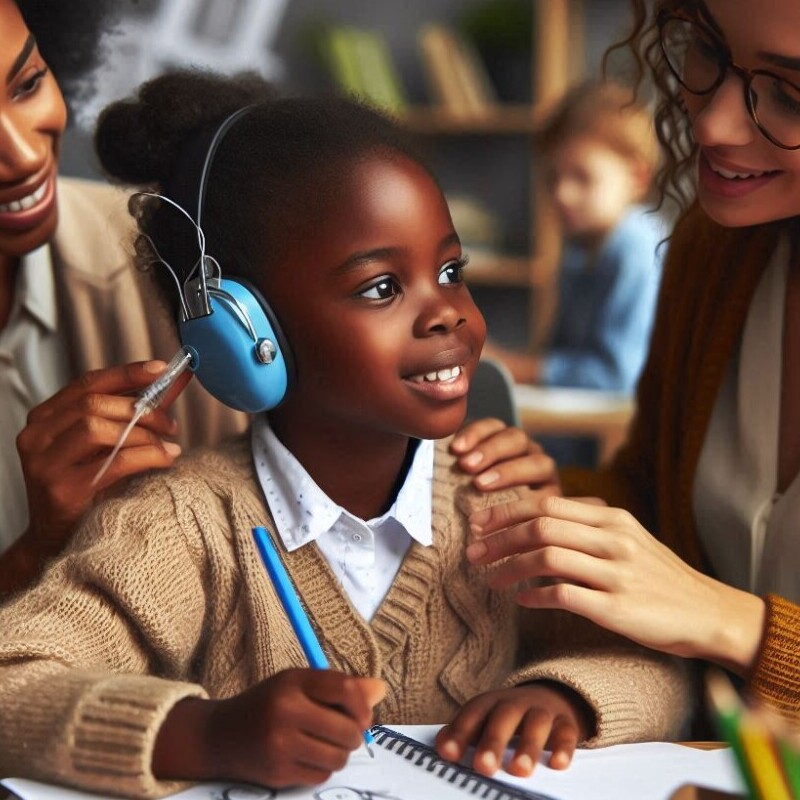Supporting children with hearing aids at school can be both a challenging and rewarding experience. It requires a deep understanding of the technology, careful adjustments inside classrooms, and a genuine commitment to creating an environment where every student feels included.
In this article, I present various approaches and practical tips to help build a more welcoming learning space for students who rely on hearing aids. By paying close attention to both the technical and human aspects of support, schools can truly help every student succeed.

Essential Considerations for Supporting Children with Hearing Aids
Many students depend on hearing aids so they can participate fully in class discussions and absorb important information. School staff and parents need to understand the specific needs of these children.
A child’s hearing aid is not just a small gadget; it is an essential connection to their learning. When teachers know how these devices work and what challenges may arise in noisy or busy environments, they can better adjust their communication methods to be clear and supportive.
This might mean speaking in a calm, measured tone, reducing background noise when possible, or thoughtfully arranging seating so that every child has a clear view of the teacher.
Resources such as the Hearing Loss Association of America and the American Speech-Language-Hearing Association offer all-in-one guides, webinars, and community support.
These organizations provide advice and tools that can make it easier for both educators and parents to remove communication barriers. By studying these materials and putting the suggestions into practice, schools can begin to truly meet every student’s unique needs.
Creating a Supportive School Environment
A key step in supporting children with hearing aids is to design a classroom environment that minimizes distractions and gives a boost to the clarity of sound. Classroom acoustics play a big role in ensuring that every student hears what is being taught.
Simple changes—such as installing sound-absorbing panels, using double-glazed windows, or even rethinking the classroom layout—can cut down on disruptive echoes and background noise.

Teachers can also consider placing students with hearing aids closer to the front, which not only amplifies the teacher’s voice naturally but also allows the child to directly see the speaker’s face and lip movements.
This small adjustment can make a world of difference in understanding spoken instructions.
Effective communication strategies are equally important. Educators are encouraged to speak clearly and at a steady pace. Training sessions that cover the benefits of clear speech and maintaining eye contact can be very useful.
Additional practical tips include pairing spoken words with visual aids such as charts and diagrams, which help cement ideas without relying solely on auditory input.
Reducing background noise by using designated quiet areas for learning or scheduling disruptive activities during non-class hours also helps create a more inclusive environment.
Recommended Reading: Choosing The Best Hearing Aid For Your Child
Quick Guide to Helping Children Adapt to Their Hearing Aids
Getting started might seem overwhelming, but breaking the process into clear, manageable steps simplifies the transition.
Here is a straightforward guide for educators and parents:
- Confirm Proper Device Fit: Ensure that the hearing aid is adjusted correctly and fits comfortably. Regular check-ups with an audiologist can confirm that the device is working as it should.
- Teach the Child About Their Device: Explain in simple terms how the hearing aid operates. Cover topics like battery replacement, cleaning routines, and volume adjustment, which gives the child a sense of ownership over their device.
- Speak Clearly and Slowly: Use natural pauses and precise enunciation so that the child has time to catch every word.
- Establish a Discreet Signal: Agree on a non-verbal cue the child can use if they are having difficulty understanding. This allows teachers to know when to repeat or rephrase important information.
- Maintain Open Communication: Keep a regular dialogue with both the child and their parents to address any ongoing or emerging issues together.
This concise approach not only builds the child’s confidence in using their hearing aid but also makes the overall learning environment much more supportive.
Challenges When Supporting Hearing Aid Users
Although many strategies can work well, some challenges are routinely encountered when supporting children with hearing aids.
Recognizing these challenges in advance makes it easier to develop practical solutions:
- Device Maintenance and Battery Life: Hearing aids require regular cleaning, battery replacements, and check-ups. A lapse in maintenance can leave a child without the necessary aid during critical moments.
- Classroom Acoustics: Many school facilities were not built with optimal sound quality in mind, leading to echoes and persistent background noise that can affect clarity.
- Peer Interaction and Social Inclusion: Beyond academic hurdles, some children may face social challenges if classmates do not fully understand their needs. This can sometimes lead to feelings of isolation.
- Academic Adjustments: Tailoring educational materials so they are accessible may involve extra revisions. This includes using larger fonts, clearer visuals, or alternative content formats designed for easier comprehension.
Advanced Strategies for Giving a Boost to Communication
Once the basics are in place, schools can explore more advanced strategies to further give a boost to communication.
One effective method involves combining auditory and visual learning techniques. Multimedia presentations, interactive whiteboards, and captioned videos are just a few examples of strategies that make the learning experience richer and more accessible for everyone.
Another promising strategy is the use of collaborative learning methods that integrate assistive technology.
For example, investing in sound field systems can help distribute the teacher’s voice evenly across the room, minimizing the impact of background noise.
Regular training sessions and workshops for educators, often hosted by organizations such as the American Speech-Language-Hearing Association, ensure that teachers remain aware of new techniques and technological advances. By staying updated, educators can continuously tweak their teaching methods to better serve all students.
Essential Tools and Resources for Schools With Hearing Aid Users
Schools that are serious about supporting children with hearing aids often benefit from investing in the right tools and technologies.
Many modern hearing aids now come with features like noise filtering and Bluetooth connectivity, opening up new possibilities for classroom integration.
The following resources are very important for creating an accessible academic environment:
- Sound Field Systems: These systems amplify the teacher’s voice evenly throughout the room, ensuring every student hears clearly, regardless of their seat location.
- Assistive Listening Devices: Portable devices that offer additional support during tests, group discussions, or any situation where sound clarity might be compromised.
- Technology Integration Platforms: Software that works with hearing aids to provide live captioning and voice amplification, which gives lectures an extra layer of accessibility.
- Support Organizations: Institutions like the Hearing Loss Association of America and the National Association of the Deaf provide guidelines, support groups, and educational resources that are indispensable for both teachers and parents.
Investing in these resources not only supports academic success but also demonstrates a commitment to leveling the playing field for every student. By pulling together effective technologies and supportive practices, schools can craft learning environments that are truly inclusive.
Frequently Asked Questions
Below are some questions that come up often when discussing support for children using hearing aids:
Question: How do schools create an inclusive atmosphere for students with hearing aids?
Answer: Teachers are encouraged to speak clearly, use visual aids, and adjust seating arrangements so that every student can clearly see and hear the lesson. Regular training and flexible classroom setups make a big difference.
Question: What should be done if a hearing aid malfunctions during school hours?
Answer: Having a clear backup plan is critical. This plan usually includes spare batteries, an established relationship with an audiologist, and immediate communication with parents to swiftly address any issues.
Question: Are there specific technologies that can help improve classroom learning for these students?
Answer: Yes, tools such as sound field systems and assistive listening devices, as well as software that offers live captioning, are proven to boost accessibility in the classroom.
Question: How can parents and teachers collaborate to support a child using a hearing aid?
Answer: Open, ongoing communication is key. Setting up regular meetings and sharing progress reports ensures that the child’s needs are met both at home and in school.
Summary and Encouragement
In wrapping up, supporting children with hearing aids in a school setting is a multifaceted yet deeply fulfilling effort.
Every adjustment—from refining classroom acoustics and using assistive technologies to rethinking teaching methods—plays a crucial role in removing learning barriers.
When teachers, parents, and support organizations work together, they help ensure that every student has the opportunity to succeed academically and socially.
Every effort, no matter how small, can empower a child to realize their potential. By staying informed, keeping an eye out for new ideas, and continuously tailoring teaching methods, schools are able to make significant positive changes.
I encourage educators and parents to explore different approaches, test new techniques, and above all, maintain open lines of communication. The goal is not just to improve classroom performance—it is about giving each child the confidence and support they deserve.
Ultimately, the success of every student depends on a community that is willing to adapt, learn, and grow together.
By taking advantage of available resources and steadily refining classroom practices, schools can turn challenges into opportunities and create environments that nurture every child’s potential.
Hope that you enjoyed the article.
All the best and take care
Roopesh

This is such a thoughtful and informative article! I really appreciate the detailed breakdown of how schools can better support children with hearing aids.
As someone who has seen firsthand the challenges children with hearing aids can face in noisy classroom environments, I know how important it is for teachers to be aware of small changes that make a big impact. I especially liked the suggestions about sound field systems and seating arrangements—those adjustments can make a world of difference.
One question I had was about peer interactions. Have you come across any strategies that help classmates better understand and support their peers with hearing aids? I imagine that social inclusion is just as crucial as academic support.
Also, do you have any recommendations for parents who may be advocating for better accommodations at their child’s school? Sometimes schools are hesitant to invest in new resources, so I’d love to hear any advice on how to approach those conversations effectively.
Thanks again for sharing these insights!
Here’s a friendly and thoughtful response to the comment:
Thank you so much for your kind words!
I’m really glad you found the article helpful. You’re absolutely right—small changes like sound field systems and seating arrangements can make a huge difference in creating a more inclusive learning environment for children with hearing aids.
Your question about peer interactions is such an important one!
Encouraging open conversations in the classroom about hearing loss and assistive devices can really help. Some strategies that have worked well include classroom presentations (with the child’s comfort in mind), buddy systems, and even fun activities that teach students about different ways to communicate. Building an environment of understanding and empathy helps foster social inclusion.
As for advocating for accommodations, one approach is to focus on the benefits for all students, not just those with hearing aids. For example, tools like sound field systems improve listening conditions for everyone, which can make it an easier sell to schools. Bringing in support from an audiologist or special education expert can also help strengthen the case. Additionally, sharing real-life success stories or research on improved learning outcomes can make schools more receptive to investing in new resources.
I really appreciate your thoughtful questions! Social and academic support go hand in hand, and conversations like these help bring more awareness to the topic. Thanks again for adding to the discussion! ????